Applying Management Accounting Techniques: Cost Analysis & Budgeting
VerifiedAdded on 2023/04/19
|8
|982
|148
Report
AI Summary
This management accounting assignment delves into cost-volume-profit analysis, flexible budgeting, and cost variances, using Lemon4U as a case study. It calculates break-even points, analyzes monthly profit, and assesses variances between budgeted and actual figures. The report also evaluates the cost-plus pricing method and explores absorption rates for dental treatments. Furthermore, it examines the impact of renting a machine on production costs and profitability, and assesses the viability of accepting a special order for candles. Finally, the assignment contrasts FIFO and CWA methods for inventory valuation, recommending the CWA method for its realism. Desklib offers a wealth of similar solved assignments and past papers for students.
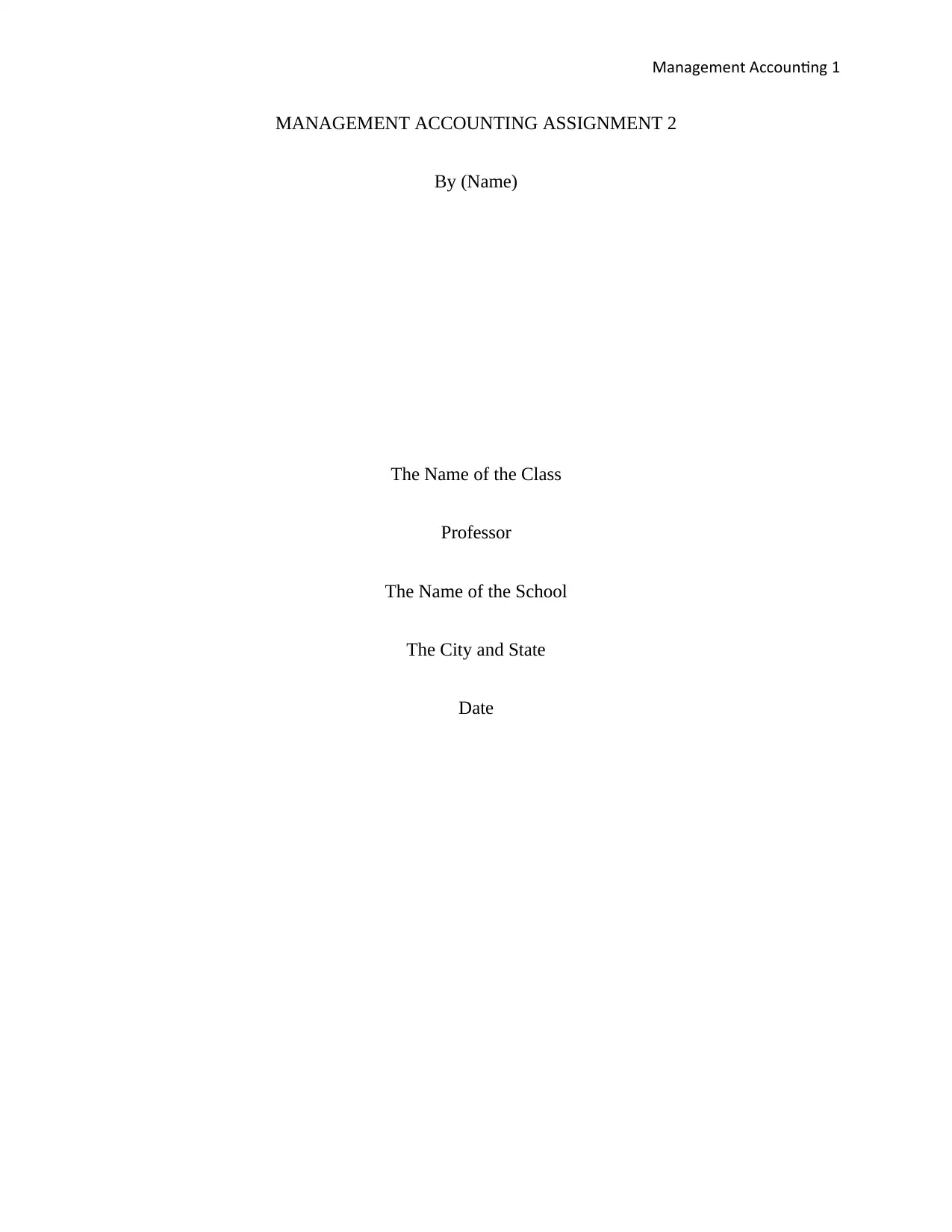
Management Accounting 1
MANAGEMENT ACCOUNTING ASSIGNMENT 2
By (Name)
The Name of the Class
Professor
The Name of the School
The City and State
Date
MANAGEMENT ACCOUNTING ASSIGNMENT 2
By (Name)
The Name of the Class
Professor
The Name of the School
The City and State
Date
Paraphrase This Document
Need a fresh take? Get an instant paraphrase of this document with our AI Paraphraser
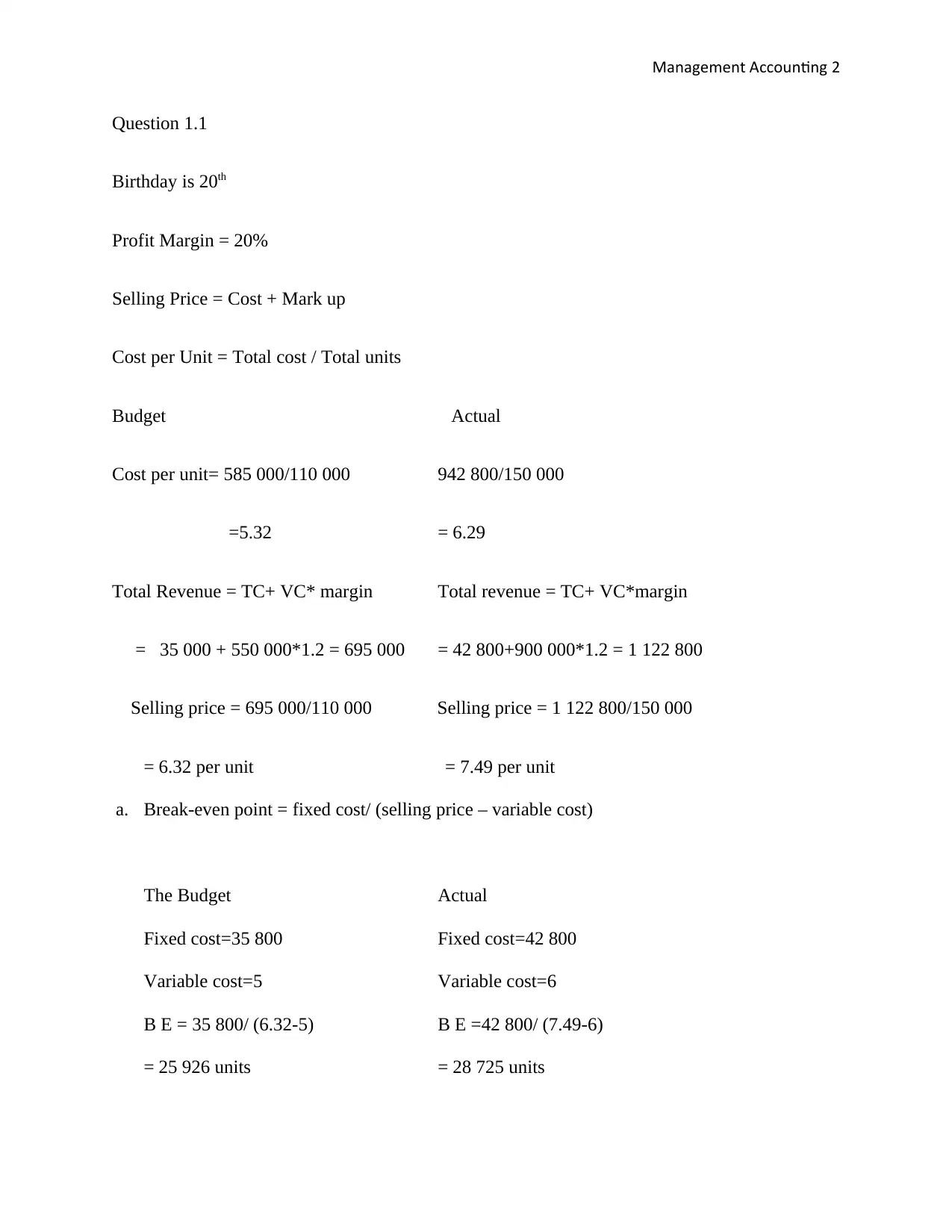
Management Accounting 2
Question 1.1
Birthday is 20th
Profit Margin = 20%
Selling Price = Cost + Mark up
Cost per Unit = Total cost / Total units
Budget Actual
Cost per unit= 585 000/110 000 942 800/150 000
=5.32 = 6.29
Total Revenue = TC+ VC* margin Total revenue = TC+ VC*margin
= 35 000 + 550 000*1.2 = 695 000 = 42 800+900 000*1.2 = 1 122 800
Selling price = 695 000/110 000 Selling price = 1 122 800/150 000
= 6.32 per unit = 7.49 per unit
a. Break-even point = fixed cost/ (selling price – variable cost)
The Budget Actual
Fixed cost=35 800 Fixed cost=42 800
Variable cost=5 Variable cost=6
B E = 35 800/ (6.32-5) B E =42 800/ (7.49-6)
= 25 926 units = 28 725 units
Question 1.1
Birthday is 20th
Profit Margin = 20%
Selling Price = Cost + Mark up
Cost per Unit = Total cost / Total units
Budget Actual
Cost per unit= 585 000/110 000 942 800/150 000
=5.32 = 6.29
Total Revenue = TC+ VC* margin Total revenue = TC+ VC*margin
= 35 000 + 550 000*1.2 = 695 000 = 42 800+900 000*1.2 = 1 122 800
Selling price = 695 000/110 000 Selling price = 1 122 800/150 000
= 6.32 per unit = 7.49 per unit
a. Break-even point = fixed cost/ (selling price – variable cost)
The Budget Actual
Fixed cost=35 800 Fixed cost=42 800
Variable cost=5 Variable cost=6
B E = 35 800/ (6.32-5) B E =42 800/ (7.49-6)
= 25 926 units = 28 725 units
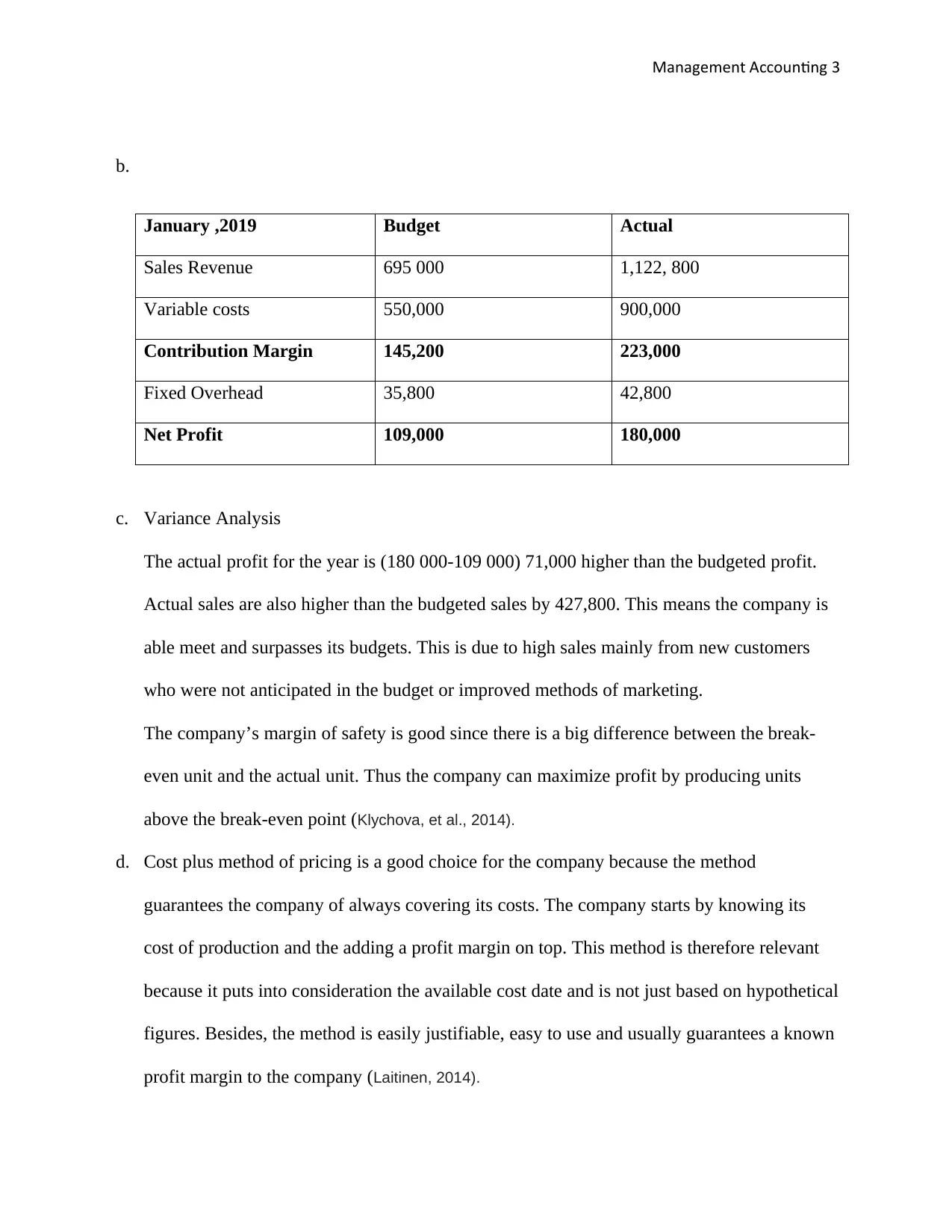
Management Accounting 3
b.
January ,2019 Budget Actual
Sales Revenue 695 000 1,122, 800
Variable costs 550,000 900,000
Contribution Margin 145,200 223,000
Fixed Overhead 35,800 42,800
Net Profit 109,000 180,000
c. Variance Analysis
The actual profit for the year is (180 000-109 000) 71,000 higher than the budgeted profit.
Actual sales are also higher than the budgeted sales by 427,800. This means the company is
able meet and surpasses its budgets. This is due to high sales mainly from new customers
who were not anticipated in the budget or improved methods of marketing.
The company’s margin of safety is good since there is a big difference between the break-
even unit and the actual unit. Thus the company can maximize profit by producing units
above the break-even point (Klychova, et al., 2014).
d. Cost plus method of pricing is a good choice for the company because the method
guarantees the company of always covering its costs. The company starts by knowing its
cost of production and the adding a profit margin on top. This method is therefore relevant
because it puts into consideration the available cost date and is not just based on hypothetical
figures. Besides, the method is easily justifiable, easy to use and usually guarantees a known
profit margin to the company (Laitinen, 2014).
b.
January ,2019 Budget Actual
Sales Revenue 695 000 1,122, 800
Variable costs 550,000 900,000
Contribution Margin 145,200 223,000
Fixed Overhead 35,800 42,800
Net Profit 109,000 180,000
c. Variance Analysis
The actual profit for the year is (180 000-109 000) 71,000 higher than the budgeted profit.
Actual sales are also higher than the budgeted sales by 427,800. This means the company is
able meet and surpasses its budgets. This is due to high sales mainly from new customers
who were not anticipated in the budget or improved methods of marketing.
The company’s margin of safety is good since there is a big difference between the break-
even unit and the actual unit. Thus the company can maximize profit by producing units
above the break-even point (Klychova, et al., 2014).
d. Cost plus method of pricing is a good choice for the company because the method
guarantees the company of always covering its costs. The company starts by knowing its
cost of production and the adding a profit margin on top. This method is therefore relevant
because it puts into consideration the available cost date and is not just based on hypothetical
figures. Besides, the method is easily justifiable, easy to use and usually guarantees a known
profit margin to the company (Laitinen, 2014).
⊘ This is a preview!⊘
Do you want full access?
Subscribe today to unlock all pages.

Trusted by 1+ million students worldwide
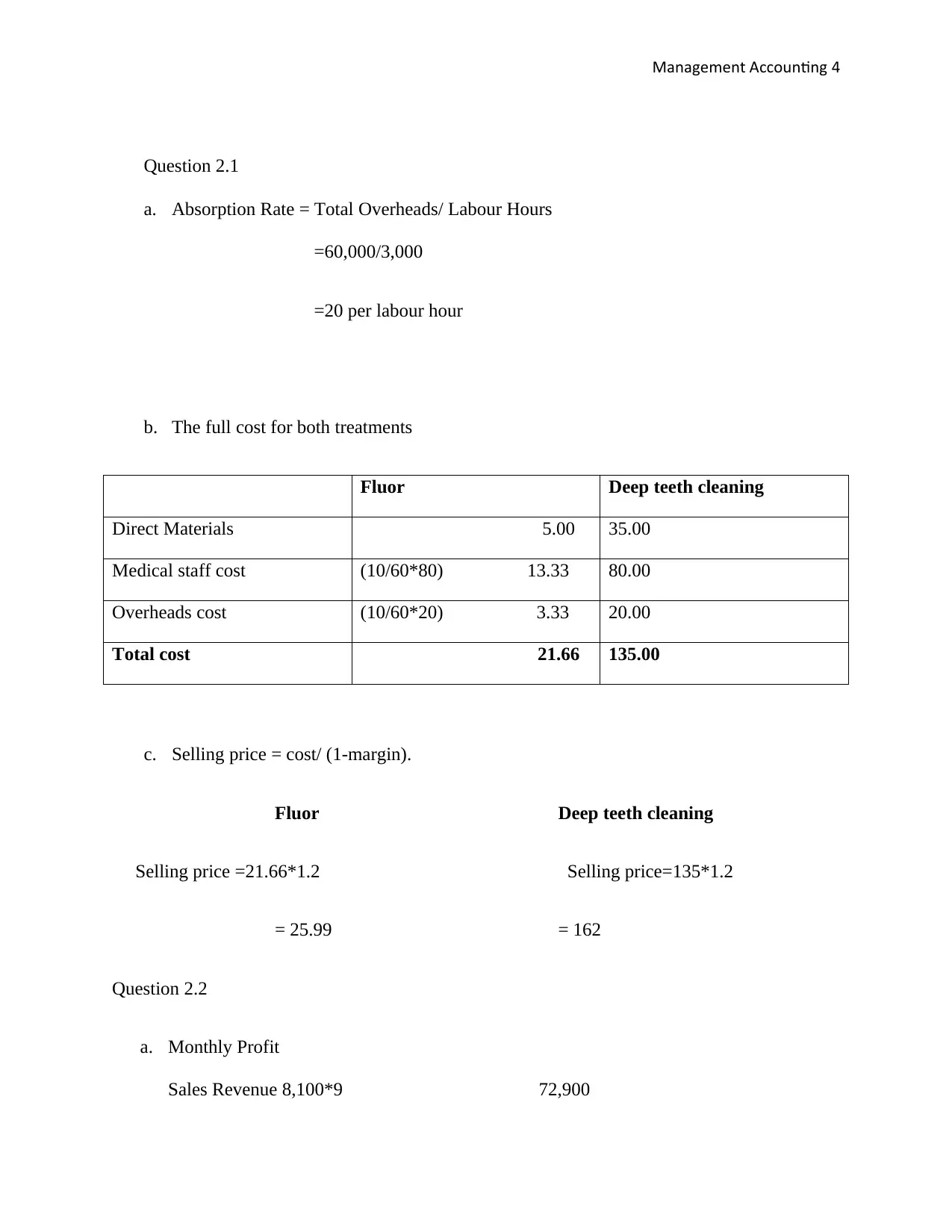
Management Accounting 4
Question 2.1
a. Absorption Rate = Total Overheads/ Labour Hours
=60,000/3,000
=20 per labour hour
b. The full cost for both treatments
Fluor Deep teeth cleaning
Direct Materials 5.00 35.00
Medical staff cost (10/60*80) 13.33 80.00
Overheads cost (10/60*20) 3.33 20.00
Total cost 21.66 135.00
c. Selling price = cost/ (1-margin).
Fluor Deep teeth cleaning
Selling price =21.66*1.2 Selling price=135*1.2
= 25.99 = 162
Question 2.2
a. Monthly Profit
Sales Revenue 8,100*9 72,900
Question 2.1
a. Absorption Rate = Total Overheads/ Labour Hours
=60,000/3,000
=20 per labour hour
b. The full cost for both treatments
Fluor Deep teeth cleaning
Direct Materials 5.00 35.00
Medical staff cost (10/60*80) 13.33 80.00
Overheads cost (10/60*20) 3.33 20.00
Total cost 21.66 135.00
c. Selling price = cost/ (1-margin).
Fluor Deep teeth cleaning
Selling price =21.66*1.2 Selling price=135*1.2
= 25.99 = 162
Question 2.2
a. Monthly Profit
Sales Revenue 8,100*9 72,900
Paraphrase This Document
Need a fresh take? Get an instant paraphrase of this document with our AI Paraphraser
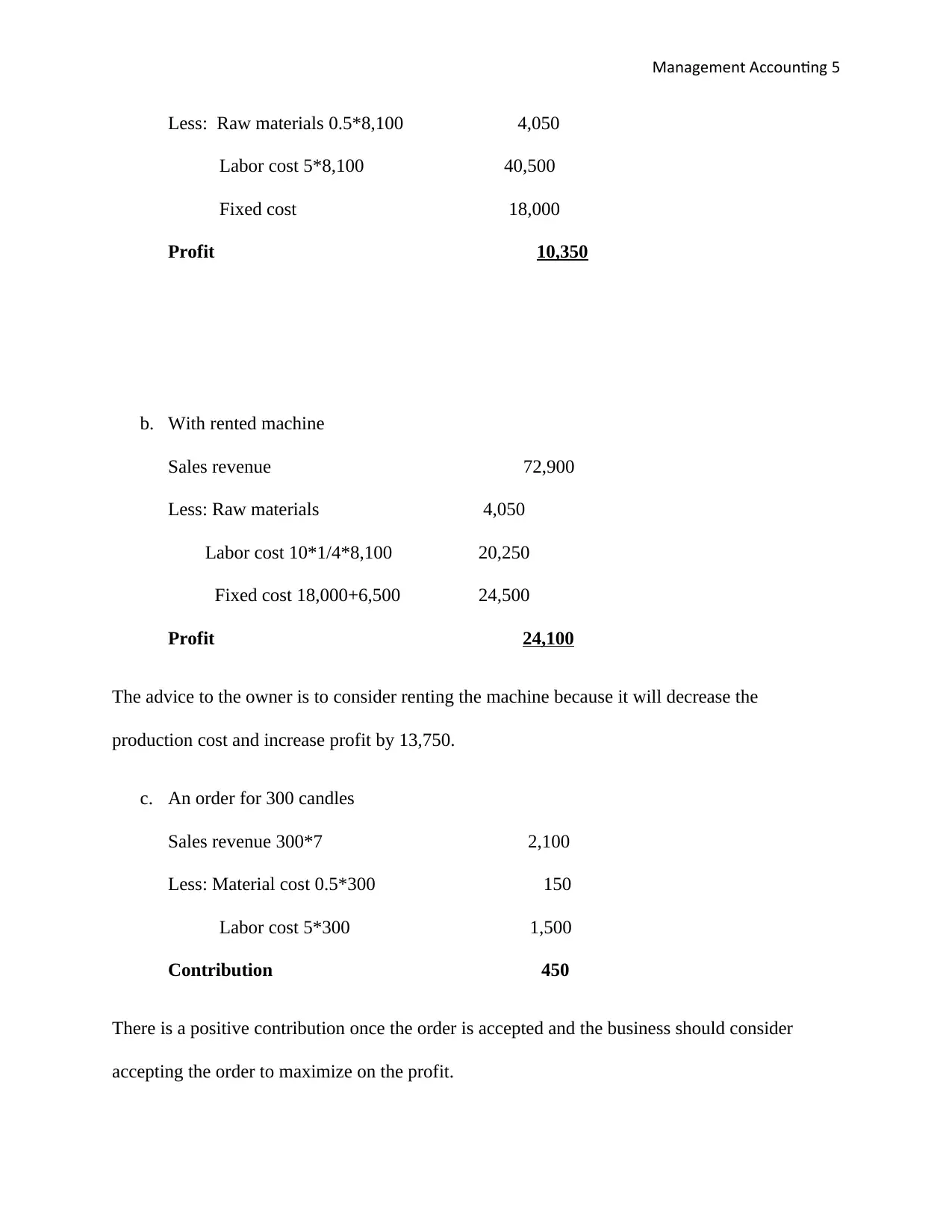
Management Accounting 5
Less: Raw materials 0.5*8,100 4,050
Labor cost 5*8,100 40,500
Fixed cost 18,000
Profit 10,350
b. With rented machine
Sales revenue 72,900
Less: Raw materials 4,050
Labor cost 10*1/4*8,100 20,250
Fixed cost 18,000+6,500 24,500
Profit 24,100
The advice to the owner is to consider renting the machine because it will decrease the
production cost and increase profit by 13,750.
c. An order for 300 candles
Sales revenue 300*7 2,100
Less: Material cost 0.5*300 150
Labor cost 5*300 1,500
Contribution 450
There is a positive contribution once the order is accepted and the business should consider
accepting the order to maximize on the profit.
Less: Raw materials 0.5*8,100 4,050
Labor cost 5*8,100 40,500
Fixed cost 18,000
Profit 10,350
b. With rented machine
Sales revenue 72,900
Less: Raw materials 4,050
Labor cost 10*1/4*8,100 20,250
Fixed cost 18,000+6,500 24,500
Profit 24,100
The advice to the owner is to consider renting the machine because it will decrease the
production cost and increase profit by 13,750.
c. An order for 300 candles
Sales revenue 300*7 2,100
Less: Material cost 0.5*300 150
Labor cost 5*300 1,500
Contribution 450
There is a positive contribution once the order is accepted and the business should consider
accepting the order to maximize on the profit.
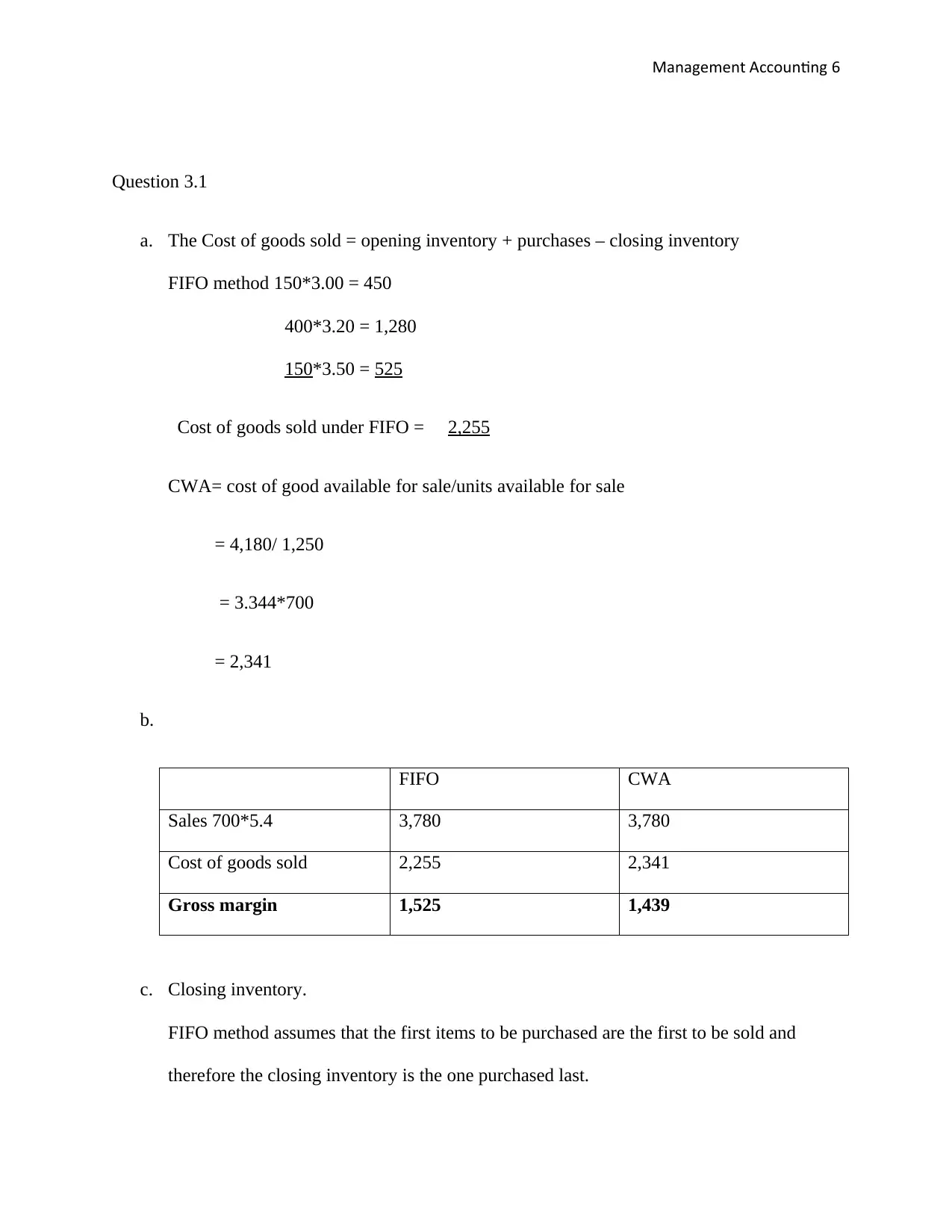
Management Accounting 6
Question 3.1
a. The Cost of goods sold = opening inventory + purchases – closing inventory
FIFO method 150*3.00 = 450
400*3.20 = 1,280
150*3.50 = 525
Cost of goods sold under FIFO = 2,255
CWA= cost of good available for sale/units available for sale
= 4,180/ 1,250
= 3.344*700
= 2,341
b.
FIFO CWA
Sales 700*5.4 3,780 3,780
Cost of goods sold 2,255 2,341
Gross margin 1,525 1,439
c. Closing inventory.
FIFO method assumes that the first items to be purchased are the first to be sold and
therefore the closing inventory is the one purchased last.
Question 3.1
a. The Cost of goods sold = opening inventory + purchases – closing inventory
FIFO method 150*3.00 = 450
400*3.20 = 1,280
150*3.50 = 525
Cost of goods sold under FIFO = 2,255
CWA= cost of good available for sale/units available for sale
= 4,180/ 1,250
= 3.344*700
= 2,341
b.
FIFO CWA
Sales 700*5.4 3,780 3,780
Cost of goods sold 2,255 2,341
Gross margin 1,525 1,439
c. Closing inventory.
FIFO method assumes that the first items to be purchased are the first to be sold and
therefore the closing inventory is the one purchased last.
⊘ This is a preview!⊘
Do you want full access?
Subscribe today to unlock all pages.

Trusted by 1+ million students worldwide
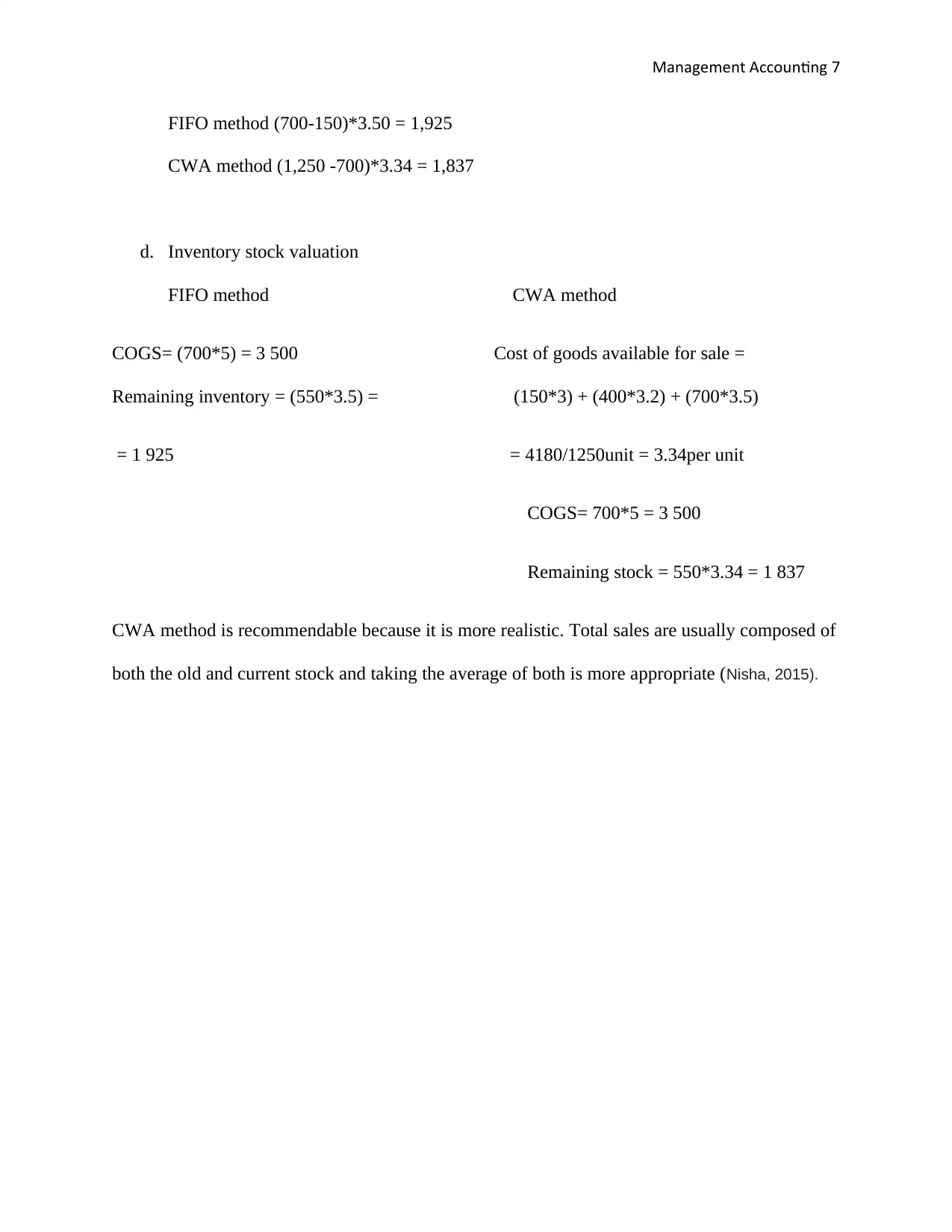
Management Accounting 7
FIFO method (700-150)*3.50 = 1,925
CWA method (1,250 -700)*3.34 = 1,837
d. Inventory stock valuation
FIFO method CWA method
COGS= (700*5) = 3 500 Cost of goods available for sale =
Remaining inventory = (550*3.5) = (150*3) + (400*3.2) + (700*3.5)
= 1 925 = 4180/1250unit = 3.34per unit
COGS= 700*5 = 3 500
Remaining stock = 550*3.34 = 1 837
CWA method is recommendable because it is more realistic. Total sales are usually composed of
both the old and current stock and taking the average of both is more appropriate (Nisha, 2015).
FIFO method (700-150)*3.50 = 1,925
CWA method (1,250 -700)*3.34 = 1,837
d. Inventory stock valuation
FIFO method CWA method
COGS= (700*5) = 3 500 Cost of goods available for sale =
Remaining inventory = (550*3.5) = (150*3) + (400*3.2) + (700*3.5)
= 1 925 = 4180/1250unit = 3.34per unit
COGS= 700*5 = 3 500
Remaining stock = 550*3.34 = 1 837
CWA method is recommendable because it is more realistic. Total sales are usually composed of
both the old and current stock and taking the average of both is more appropriate (Nisha, 2015).
Paraphrase This Document
Need a fresh take? Get an instant paraphrase of this document with our AI Paraphraser
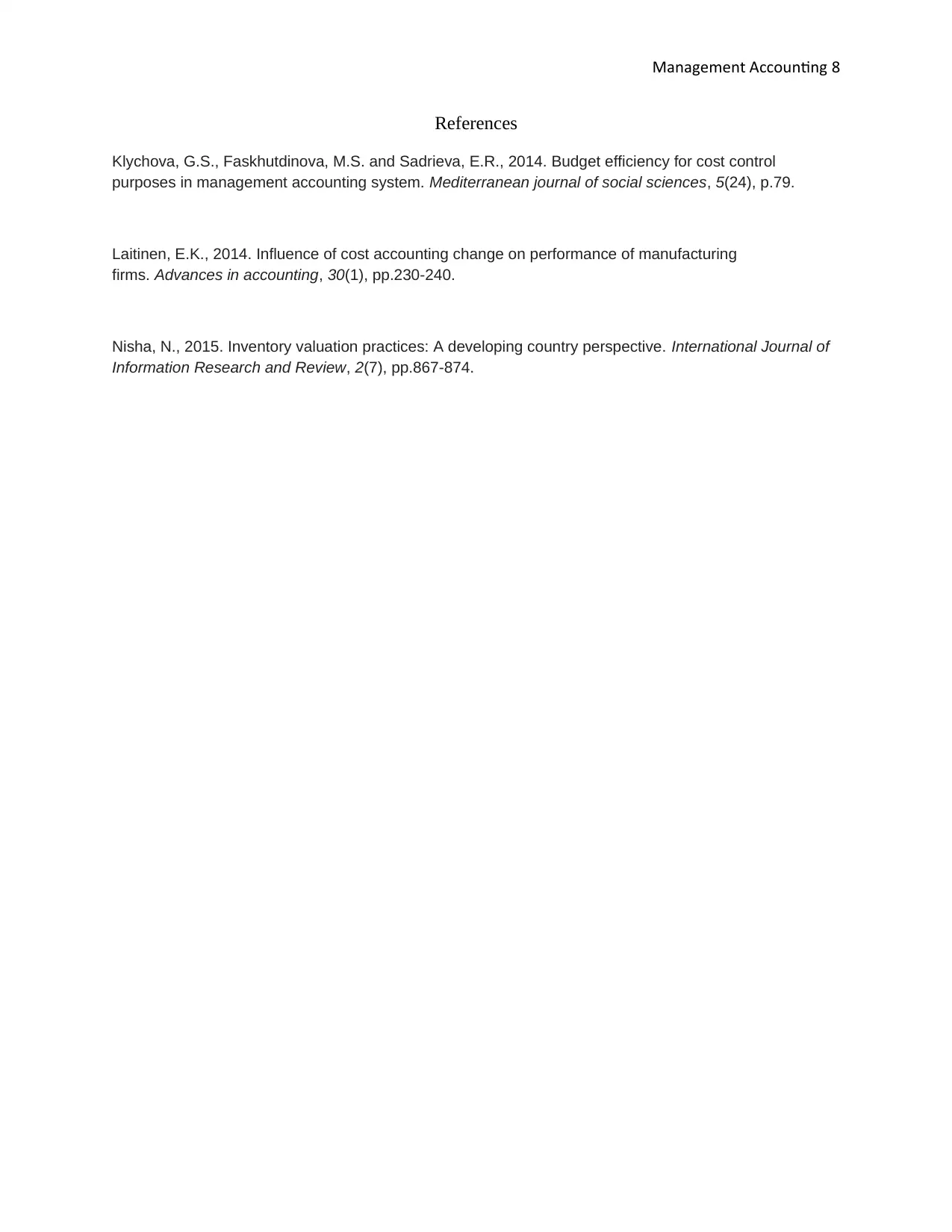
Management Accounting 8
References
Klychova, G.S., Faskhutdinova, М.S. and Sadrieva, E.R., 2014. Budget efficiency for cost control
purposes in management accounting system. Mediterranean journal of social sciences, 5(24), p.79.
Laitinen, E.K., 2014. Influence of cost accounting change on performance of manufacturing
firms. Advances in accounting, 30(1), pp.230-240.
Nisha, N., 2015. Inventory valuation practices: A developing country perspective. International Journal of
Information Research and Review, 2(7), pp.867-874.
References
Klychova, G.S., Faskhutdinova, М.S. and Sadrieva, E.R., 2014. Budget efficiency for cost control
purposes in management accounting system. Mediterranean journal of social sciences, 5(24), p.79.
Laitinen, E.K., 2014. Influence of cost accounting change on performance of manufacturing
firms. Advances in accounting, 30(1), pp.230-240.
Nisha, N., 2015. Inventory valuation practices: A developing country perspective. International Journal of
Information Research and Review, 2(7), pp.867-874.
1 out of 8
Related Documents
Your All-in-One AI-Powered Toolkit for Academic Success.
+13062052269
info@desklib.com
Available 24*7 on WhatsApp / Email
![[object Object]](/_next/static/media/star-bottom.7253800d.svg)
Unlock your academic potential
Copyright © 2020–2025 A2Z Services. All Rights Reserved. Developed and managed by ZUCOL.





